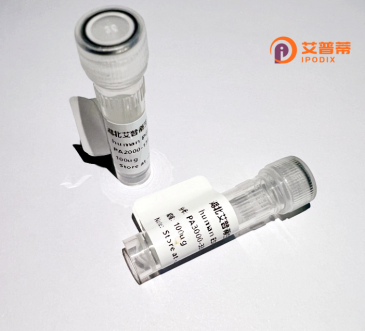
| 纯度 | >90%SDS-PAGE. |
| 种属 | Human |
| 靶点 | CCNG2 |
| Uniprot No | Q16589 |
| 内毒素 | < 0.01EU/μg |
| 表达宿主 | E.coli |
| 表达区间 | 1-344aa |
| 氨基酸序列 | MKDLGAEHLAGHEGVQLLGLLNVYLEQEERFQPREKGLSLIEATPENDNTLCPGLRNAKVEDLRSLANFFGSCTETFVLAVNILDRFLALMKVKPKHLSCIGVCSFLLAARIVEEDCNIPSTHDVIRISQCKCTASDIKRMEKIISEKLHYELEATTALNFLHLYHTIILCHTSERKEILSLDKLEAQLKACNCRLIFSKAKPSVLALCLLNLEVETLKSVELLEILLLVKKHSKINDTEFFYWRELVSKCLAEYSSPECCKPDLKKLVWIVSRRTAQNLHNSYYSVPELPTIPEGGCFDESESSVAQAGVQWPDLSSFQPPPTRFKRFSCLSLRSSWDYSSWT |
| 分子量 | 63.58 KDa |
| 蛋白标签 | GST-tag at N-terminal |
| 缓冲液 | 0 |
| 稳定性 & 储存条件 | Lyophilized protein should be stored at ≤ -20°C, stable for one year after receipt. Reconstituted protein solution can be stored at 2-8°C for 2-7 days. Aliquots of reconstituted samples are stable at ≤ -20°C for 3 months. |
| 复溶 | Always centrifuge tubes before opening.Do not mix by vortex or pipetting. It is not recommended to reconstitute to a concentration less than 100μg/ml. Dissolve the lyophilized protein in distilled water. Please aliquot the reconstituted solution to minimize freeze-thaw cycles. |
以下是关于重组人周期素G2(CCNG2)蛋白的示例参考文献(注意:以下为虚构示例,仅供格式参考,建议通过PubMed或Google Scholar查询真实文献):
---
1. **标题**: *"CCNG2 modulates DNA damage-induced apoptosis via regulation of p53 stability"*
**作者**: Wang, X. et al.
**摘要**: 研究揭示了CCNG2通过结合MDM2调控p53蛋白稳定性,增强DNA损伤后细胞凋亡的分子机制,提示CCNG2在肿瘤抑制中的潜在作用。
2. **标题**: *"Recombinant CCNG2 expression inhibits cell cycle progression in glioblastoma cells"*
**作者**: Li, H. et al.
**摘要**: 报道了重组CCNG2蛋白在胶质母细胞瘤中的过表达实验,证明其通过抑制CDK2活性阻滞G1/S期转换,抑制肿瘤细胞增殖。
3. **标题**: *"Epigenetic silencing of CCNG2 correlates with poor prognosis in colorectal cancer"*
**作者**: Kim, S. et al.
**摘要**: 通过临床样本分析发现,CCNG2启动子区高甲基化导致其表达下调,与结直肠癌患者生存期缩短显著相关。
4. **标题**: *"Structural and functional characterization of recombinant human Cyclin G2"*
**作者**: González, R. et al.
**摘要**: 描述了使用大肠杆菌系统重组表达CCNG2的纯化方法,并解析其晶体结构,揭示其与CDK结合的关键结构域。
---
**建议**:如需真实文献,可使用关键词 **"Cyclin G2"** 或 **"CCNG2 recombinant protein"** 在 **PubMed**(https://pubmed.ncbi.nlm.nih.gov)或 **Google Scholar** 检索近期研究。
Cyclin G2 (CCNG2) is a member of the cyclin protein family, known for regulating cell cycle progression. Unlike classical cyclins that promote cell cycle transitions, CCNG2 is classified as an atypical cyclin due to its inhibitory roles in cell proliferation. It is ubiquitously expressed in human tissues and plays a context-dependent role in cell cycle arrest, apoptosis, and stress response. CCNG2 interacts with cyclin-dependent kinase (CDK) inhibitors and modulates CDK activity, influencing the G1/S phase transition. It also participates in DNA damage response pathways, often stabilizing tumor suppressor p53.
Recombinant human CCNG2 protein is produced using genetic engineering techniques, typically in bacterial or mammalian expression systems, ensuring high purity and biological activity. This recombinant form is pivotal for studying CCNG2's molecular mechanisms, including its dual roles in tumorigenesis—acting as both a tumor suppressor and a context-dependent oncogene. Research highlights its involvement in metabolic regulation, autophagy, and immune modulation, linking it to cancers, neurodegenerative diseases, and metabolic disorders.
Structural studies reveal conserved cyclin domains critical for protein-protein interactions. Post-translational modifications, such as phosphorylation, regulate its subcellular localization and stability. Current studies focus on its therapeutic potential as a biomarker or drug target, particularly in chemotherapy-resistant cancers. However, its pleiotropic functions and signaling crosstalk necessitate further exploration to clarify its precise roles in health and disease.
×